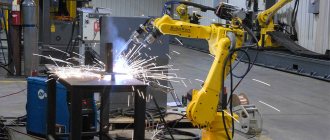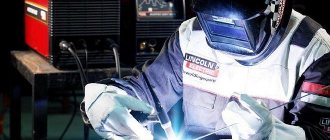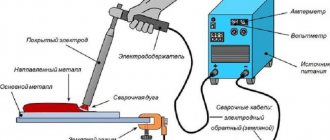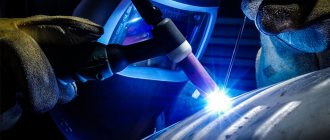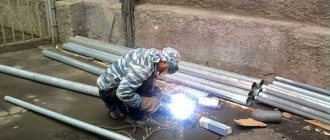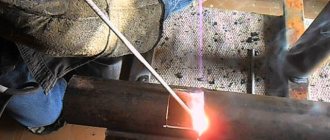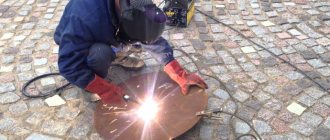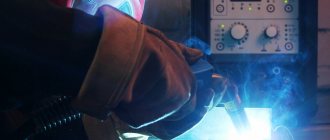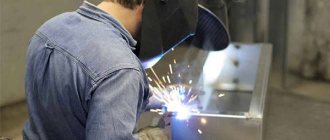When there is a need to connect two metal sheets, pipe elements; to make a fence or staircase from iron, use conventional arc welding and electrodes. The method was invented back in 1882. For the first time, an electric arc was used to connect metal workpieces by the Russian scientist N.N. Benardos. The first electrode used was carbon.
The new method has become in demand in industrial production and in the construction of railways. The electrodes were ordinary steel wire without any coating. Therefore, the composition of the weld practically did not differ from solid metal. Due to the fact that there was no protective environment, there were many defects inside the melt: cracks, voids and cavities. The situation changed radically after the advent of coated piece electrodes. Such a consumable was first made in 1907 by the Swedish inventor Kjellberg, and the coating was a layer of silicate glue.
Process concept
MMA electric arc welding is based on the principle of melting the edges of the metal parts being joined by the temperature of the electric arc. When the boundary sections of the parts to be joined are melted, a so-called weld pool appears, which, upon cooling and crystallization, forms a weld, ensuring a reliable permanent connection of the parts.
There are several types of electric arc mma welding:
- manual electric arc welding (mma) using replaceable consumable electrodes;
- electric arc process, which uses non-consumable electrodes for welding;
- arc welding with consumable wire with its continuous supply in a protective gas environment, implemented in semi-automatic welding machines.
In each of them, the name mma fully justifies itself, since the welder plays a large role in the process of joining metal.
The essence of MMA welding
The main feature of MMA welding is the formation at the joint of an alloy containing components of the surfacing and base metal. What is “surfacing” – these are electrodes for mma technology that are melted during operation. Electrodes are marked by alloy:
- with a carbon steel core are designated by the letter symbol “U”;
- highly alloyed - “B”.
During the heating process, the additive and the edges form a common melt pool. Metals are mixed under the influence of an arc. Crystallizing, they form a tight seam, an inseparable homogeneous connection.
To generate an arc in MMA welding, a closed electrical circuit is created; two wires are drawn from the power source. When metal and additive come into contact, the electrical circuit is closed.
Varieties of manual welding
The term MMA welding refers to manual arc welding with a consumable electrode. In this process, a weld is formed by fusing the parts to be welded with the electrode material. MMA electric arc welding is carried out using direct or alternating current.
AC Application
This type of welding assumes that the polarity of the arc changes every half cycle when the voltage value passes through zero. Thus, each half-cycle, when the voltage approaches zero, the arc is extinguished and subsequently ignited.
This process is invisible to the eye, and the arc is perceived as continuously burning. Re-ignition of the arc occurs easily due to the high residual ionization of the spark gap and the short arc interruption time. The source of alternating current for MMA welding is a step-down transformer.
DC Application
This welding method requires that the electrode have constant polarity. There are the following methods of MMA welding with direct current:
- the process of reverse polarity, when the welding electrode is connected to the minus of the power source, and the parts being welded are connected to the plus;
- a process of direct polarity, in which the electrode has a positive potential, and the workpiece being welded has a negative potential.
Each method has its own characteristics. Reverse polarity is used when working with thicker metal, since in this mode the heating and melting of the workpiece occurs more intensely.
The electrode material, on the contrary, is consumed more slowly. With straight polarity, the electrode melts more intensely than the workpiece. For this reason, this method is used for MMA welding of thin metal products.
MMA welding with direct current is carried out by rectifiers, generators and inverter converters.
Advantages and disadvantages
MMA welding does not require complex equipment. Universal, can be performed in any position. Limitations are associated only with the physical properties of the alloys:
- increased fluidity;
- degree of oxidation.
The technology is applicable to most metals; work can be carried out in the field. MMA welding is used for domestic purposes and in production.
Now about the disadvantages:
- difficulty igniting and maintaining the arc;
- harmful factors affecting the health of the welder (vapors generated when electrode coating melts, volatile metal vapors).
The advantages prevail, so MMA technology is applied in various fields.
MMA welding is universal and is used in various fields, for domestic purposes and in production.
Equipment used
The sources of welding current are autonomous generators, step-down transformers, as well as MMA type inverter converters that have appeared relatively recently.
Welding generator
The generator for MMA welding is usually a synchronous electric machine driven by an internal combustion engine, diesel or gasoline. Structurally, such a generator is very close to units designed to provide backup power.
The difference lies in the level of output voltage (for welding units it is usually 70 - 75 Volts) and the presence of a rectifier unit that provides direct current welding.
The identity of the main components of welding and backup generators determines the fact that such machines are usually designed as universal ones. By switching the output voltage level and eliminating the rectifier unit, the unit turns into a regular backup power generator.
Welding transformer
This is a traditional power source used in MMA welding. It is a conventional step-down transformer with a secondary no-load voltage of 50 to 80 Volts. By design, they are three-phase, for a voltage of 220/380 Volts, or single-phase, for 220 or 380 Volts.
Single-phase transformers are typically used for AC welding and do not contain rectifiers. Three-phase converters are equipped with diode bridges and are used for MMA welding with direct current.
This is explained by the fact that single-phase alternating voltage, after rectification, is a sequence of pulsations with an amplitude from 0 to maximum voltage, which causes instability of the arc when welding with a direct current electrode. Therefore, single-phase MMA rectifiers require the use of ripple-smoothing means in the form of powerful chokes and bulk capacitors.
Three-phase MMA rectifiers produce a voltage that is much closer to constant and has slight ripple. Such MMA welding machines are currently most widely used in manufacturing enterprises, providing high quality welded joints.
Welding inverter
It is no exaggeration to say that this type of equipment has revolutionized the welding business. The principle of its operation is as follows: the input voltage (most often single-phase, 220 Volts) is rectified, then supplied to a high-frequency inverting generator (up to 100 kHz), built on powerful IGBT transistors.
After this, the high frequency alternating voltage is transformed to the required level and rectified. As a result, a constant voltage with high-frequency pulsations superimposed on it is formed at the output of the MMA device (or another type).
This property of the inverter apparatus allows you to perform work using various types of electrodes. Welding electrodes designed to work with direct current, as well as those designed for alternating current mma welding, can be successfully used.
Well, the most important thing that inverter technology has brought is that the welding machine has significantly decreased in size and weight. This became possible thanks to the features of high-frequency voltage conversion.
The fact is that a transformer that lowers the voltage with a frequency of tens of kilohertz to the required level is an order of magnitude smaller and lighter than one operating with a frequency of 50 Hz at the same power.
The same can be said about filter capacitors. As a result, instead of a transformer, the movement of which was only possible with the use of lifting equipment, the welder received a portable mma welding inverter, carried on a shoulder strap and performing the same functions.
Equipment
You already know what MMA TIG MIG is, now let’s talk about the types of machines for each type of welding work.
With inert gas
The gas is in cylinders with specific markings; a reducer is installed on top that regulates the amount of gas supplied. The MIG method uses inert gases, which are much more expensive than active analogues; for example, the price of carbon dioxide is 45 times less than argon, and compared to helium, the cost is reduced by another 3.5 times.
When welding MAG, carbon dioxide or nitrogen is used as protection, but to avoid a negative impact on the result, wire with the addition of manganese or silicon is used, since they do not allow the molten metal to oxidize.
With non-melting rod
In the CIS countries, the TIG method is argon arc welding, named after the gas used for protection; a non-consumable electrode simplifies the entire process, and the absence of foreign inclusions allows you to obtain a high-quality seam. The pulsed version of the welding process is similar in its properties to TIG, only a non-constant current is used, this mode is found in MAG/TIG units. It is used for joining thin sheets, since there is no overheating or warping of the surface, and the seam joint has the appearance of scales.
The MMA welding process was described in detail earlier, recall that it is characterized by the formation of an arc between a consumable electrode and the workpiece.
After hardening, the seam is covered with scale from the frozen slag, which is easily removed by tapping the surface with a hammer.
Semi-automatic
Almost all service stations have a MIG/MAG welding machine installed, because its use produces a high-quality seam that does not require additional processing. Inverters are used because they are connected to a regular electrical network, have small dimensions and weight, and are also mobile.
The power source for most devices is identical, so manufacturers have launched the production of universal equipment that allows you to operate in different modes, you just need to change the burner.
Additive wire
MIG MAG TIG methods use special installations in semi-automatic machines for continuous supply of wire, the characteristics of which determine the quality of the seams. When a powder type of additive is used, shielding gas is not needed.
The following types are used in production: aluminum-based, steel, partially or fully copper-plated, and flux-cored wire. The last two options are of particular quality and widespread - the absence of splashes is guaranteed, which increases the quality and speed of welding.
Semi-automatic station wagon
The Triton MIG device is a striking example of versatility; it belongs to equipment for professionals.
The compact-sized inverter is installed on small wheels, produces a current of no more than 250 A, ensures normal operation in all existing modes, and carries out seams using Spot/Stitch technology. The package includes three burner options that are easy to replace. At peak mode, the operating time is 60%, and at 200 A - 100%. For reliability and ease of ignition activation, there is a special function and contact activation of the arc. The equipment allows you to connect different metals, as well as galvanized sheets.
Spot/Stitch
In this mode, the equipment operates in the following way: a drop of molten wire is transferred to the product in the absence of short circuit (short circuit), so there is no overheating and warping of the surface. A similar technique is used to firmly connect stainless steel sheets or galvanized workpieces. A slight heating increases the life of the device and improves overall performance.
Electrodes for manual arc welding
Stick electrodes used for MMA welding are metal rods coated with a special compound, sometimes called coating. The function of the coating is as follows.
When an electric arc is ignited, the electrode coating, due to intense heating, abundantly releases gases that displace air oxygen from the welding site, which protects the weld pool from oxidation. This contributes to the formation of a higher quality weld.
Welding electrodes vary in diameter, rod material and coating composition. These factors determine their purpose for operating with direct or alternating current, as well as their use in connecting various materials.
How does welding happen?
The choice of welding current is approximately determined by the graph:
or be according to Table 1.
MAG welding mode (CO2 environment)
Table 1
Welding is carried out at an open circuit voltage of 19-30 V, depending on the features of the semi-automatic machine. On most household and semi-professional semi-automatic welding machines, the current supply speed and voltage are constant and not adjustable. This is done for the purpose of automatic stabilization of the arc (autocorrection).
For welding different metals, the choice of wire diameter and welding current is of primary importance. The main relationships are shown in Table 2.
table 2
The mechanism for moving the welding wire is highly complex and provides very convenient semi-automatic functionality. The MAG/MIG semi-automatic welding machine is equipped with a feed system that allows:
- perform a soft start - the wire at the beginning of welding comes out at a lower speed and allows you to ignite and stabilize the arc;
- after stopping the feed, protect the wire from welding into the torch by stopping the current supply before the wire stops;
- prevent wire sticking at the beginning of the welding process;
- smooth regulation or ensuring a constant feed rate;
- perform pulse welding mode;
- change polarity (for cored wire).
As a rule, MAG/MIG welding is performed on a current of reverse polarity - on the electrode “+”, on the product “-”, but, depending on the tasks facing the welder and the parameters of the machine, direct polarity and alternating current are also possible.
The device can operate in the following modes:
- Short Arc - used below 200 A for thin metals;
- Spray Arc - current ≥200 A and wire diameter greater than 1 mm;
- Pulse Arc - welding with a large wire diameter and low current, used for non-ferrous metals, stainless steel and aluminum, complex alloys;
- Pulse on Pulse Arc - double pulse with variable current, used for decorative seams.
Application
To fully understand the question of what MMA is, you should consider the area of use of this method.
The method is used in almost any conditions and is considered universal . Widely used on assembly and construction sites where welding is performed in places that are inaccessible to welding machines. In addition, MMA is often used outdoors.
The method is used when welding pipeline elements, in small repair and production shops, and for underwater welding. It is no less often used by home craftsmen who prefer to carry out all household work themselves.
Modes of reference
The invention and widespread use of inverters prompted the emergence of several new welding methods. The most common of them are TIG and MMA. What is MMA and TIG welding? To answer this question, you need to consider the features of both connection methods.
To work with MMA welding, consumables are required - electrodes that must be replaced.
TIG (argon arc welding) is a method that requires the use of a gas cylinder, a torch and a non-consumable tungsten electrode. This method is used much less frequently, but is still popular. The advantage of TIG welding is the ability to join thin-walled products or parts made of non-ferrous metals. The seam turns out very neat, the work requires significantly less energy and labor costs.
The disadvantage of TIG welding is the inability to work with products of significant thickness . Most modern inverters are manufactured in a universal design and allow the use of both modes.
Dmitry Kamushkin, welder, 15 years of work experience: “Like any other method, MMA may at first seem labor-intensive and incomprehensible. Not all beginners are able to quickly understand the intricacies of the process and do their job correctly. The method requires maximum patience and gradual acquisition of skills, so first it is better to practice on pieces of metal unsuitable for construction.”
Technology
The first step is to set up the mma welding mode. It is important to do this correctly so that later there are no difficulties when welding. The process is within the power of a true master; a beginner can try to do everything correctly with some effort.
After this, the arc is ignited. The process is possible either by striking or tapping. In the first case, you need to run the metal along the metal level, in the second, tap the end of the electrode on the structure.
This can be difficult for a newbie without at least two years of experience. But everything comes with practice. After 2-3 months of regular work, you will be able to light an arc without effort.
For stable arcing, it is important to keep the electrode a few millimeters from the metal. At a large distance, the arch may go out, and if it comes into contact with metal, it may stick to it.
Ensure that the metal is heated. To do this, move the electrode in a circular motion. A weld pool is formed in front of you, the size of which should be the same throughout the entire seam.
After the structure is heated, it is important to move the electrode at a medium pace. Make sure the seam is formed evenly. The entire process must be free of visible defects.
What is it and how does it work
Let's analyze this point in detail. When we work with a voltage source, we connect it to electricity. Then we take 2 cables - direct and reverse polarity.
They conduct current to the parts. We attach the first wire to the part using a clamp. Cable No. 2 is connected to the electrode. We got an electrical circuit.
It will close when power is supplied to the voltage source. We get a welding arch at a temperature capable of melting a metal structure.
The metal will lose temperature and turn into crystals when the electrical grid loses connection with the current source. The weld is made through simple steps.
The electrode plays an important role in the entire process. During its melting together with the metal, drops of the former end up in the weld pool. A seam is formed and protection from the negative effects of ozone is provided.
Electrodes are wire made of metal. It is covered with a coating that directly depends on the type of metal. Take this into account so that the work does not have to be redone.
Essence of the method
The arc is ignited between the edge of the base metal of the workpiece and the end of the melting coated electrode. Under the thermal influence of the arc, a weld pool forms on the part and the filler electrode melts, which, as it melts, is fed into the welding zone. The weld is formed as a result of mixing the base metal of the welded edges and the filler metal of the electrode.
Harmful impurities float to the surface of the weld pool in the form of slag. After complete crystallization of the weld pool, the slag crust is removed.
Protection of the molten metal from the harmful effects of the environment (oxygen and nitrogen) is provided by an electrode coating, which releases a protective gas when melted.
In addition, the electrode coating facilitates the ignition of the arc, maintains the stability of its combustion and contains slag-forming elements.
Automatic feeder
The device for constant supply of filler wire delivers without slipping or chewing; a cassette weighing from 5 to 15 kg, with a diameter of 0.8-1.2 mm, is loaded into the inverter. The detailed configuration of the automatic feed looks like this:
- The welding hose consists of a flexible frame cable covered with multi-layer rubber that protects and insulates the power cable. Inside there is a spiral-type channel for continuous wire feeding and an insulated shielding gas supply hose.
- The additive supply mechanism carries out constant movement of the wire along the channel, consists of an electric motor and pressure rollers configured for a certain force.
- Compartment for installing a coil with wound wire. It is located next to the feed mechanism, and the container with the additive is located vertically or horizontally relative to the latter. Fixation occurs with a clamp or nut.
- The feed control unit makes adjustments. There are two methods - electronic, using a rheostat, or mechanical, using replaceable gears.
Modern models have digital displays where the exact wire feed speed is set to ensure the quality of seam formation.
V. P. Ignatenko, education: college, specialty: 4th grade welder, work experience since 2000: Automatic wire feeding makes the work of the performer easier and speeds up productivity, but you need to be careful and have some experience.
How to learn to weld metal with an inverter
Begin training by igniting the arc. To do this, in addition to the apparatus, metal (5-6 mm thick) and an electrode, you will also need a welder’s mask and leggings (thick leather gloves), as well as thick clothing and boots made of thick leather to protect against sparks and scale.
Start work by connecting the welding cables. Then the selected electrode is inserted into the holder (to start, take MP 3 with a diameter of 3 mm - they light easily and cook well). After turning on the power, set the welding current (see table). For an electrode with a diameter of 3 mm, the current is set to 90-120 A. The current can be adjusted during the welding process. If you see that the result is not a roller, but just some disjointed stripes, increase it. If, on the contrary, the metal is very liquid and it is difficult to move the weld pool, reduce it. The settings greatly depend on the device and the selected electrode. So try it, change it. Having set the current, put on a welder’s mask (it will be easier for beginners to work in a chameleon mask), and you can work.
General recommendations for choosing the diameter of the electrode depending on the thickness of the metal
Welding with an inverter for beginners begins with learning how to ignite an arc. There are two methods: tap the tip of the electrode on the part several times or strike it like a match. Both methods work. Whichever is more convenient for you, use it. But for the future, keep in mind that you need to scratch along the seam line so that there are no marks left on the product. To consistently strike an arc, you will have to practice for a while and burn several electrodes.
When the arc lights up without any problems, you can move on and master the movements. This is done by laying rollers on thick metal. On a metal plate, draw a line with chalk that will replace your seam. Then you strike the arc. In the place where it rests, the metal melts and becomes covered with a film of liquid slag. This place is called the weld pool. So you will have to move it along the drawn line. Do this with one of the movements shown in the figure above.
In order for the bath to move, the electrode must be tilted slightly, approximately at an angle of 50-45°. Some have a larger angle, some have less. In general, by tilting the electrode, you change the size (width) of the weld pool. You can experiment: there are a lot of different techniques in welding and the only important thing is that the seam is of high quality, and how you achieve this is your business, especially since you will be working for yourself and for yourself.
There are two main working positions of the electrode: forward and backward. When welding at an angle forward, we get less heat and the seam will be wider. This technique is used when welding thin metals . Thick ones are usually welded at an angle backwards.
Electrode positions for welding and their use
But the angle of inclination is not all the parameters that will have to be maintained. There is also the length of the arc. This is the distance from the tip of the electrode to the surface of the part. The average arc is 2-3 mm, the short one is 1 mm or even right next to each other, the long one is 5 mm or more until it comes off. Practice begins with working on the average length of the arc. Maintain 2-3 mm to metal. Then the seam will be smoother and of better quality: if the gap is too large, the arc begins to jump, the heating of the metal is insufficient, the seam turns out to be smeared, and the connection is unreliable. With a short arc, another problem arises - the seam is too convex due to the fact that the heating zone is too small. This is also not good, since undercuts remain - grooves along the seam on the part - reducing the strength of the connection.
The length of the welding arc and its effect on the quality of the seam
After practicing for some time laying beads using different movements, and when the beads are the same width and the surfacing flakes are approximately the same size, you can try welding the seams. You can read about the types of seams and joints, as well as their preparation, here, or you can watch another lesson, “Welding for Dummies.”
All the basics of welding with an inverter for beginners. All you have left is practice: you need to use more than one electrode for training. Even, maybe, more than one kilogram. When your hand makes all the movements itself, everything will seem completely uncomplicated to you.
To consolidate the acquired knowledge, first try to train your hand a little without an electrode, practicing movements while holding a pencil in your hand. This is also a good option, maybe it will seem more acceptable to you. This video tutorial on welding with an inverter for beginners explains everything very clearly, simply and easily. If there are any uncertainties, please review. You will understand how to cook using inverter welding. Lots of useful information for beginner welders.
And finally, about some features of the operation of welding inverters. They are very afraid of dust, especially metal dust. Therefore, it is advisable not to use an angle grinder near them and carry out regular cleaning with a vacuum cleaner inside (after the warranty period has expired). It is not recommended to use them in the rain or in damp areas. This is especially true for inexpensive household models. Although they have protection against electric shock, it is still better to be safe.
When choosing electrodes, pay attention to the area of their use: they must be suitable for direct current operation. When welding at the highest current or voltage, the operating mode is intermittent. It is indicated for each device in the passport.
Main types of welding
Welding is a complex process that is performed at a temperature slightly above the melting point of the metal. A peculiarity of welding is that not the entire volume of the metal product is heated, but only the edge of the part that will be connected to another part.
It is most convenient to heat using an electric arc. It is created between a special device - an electrode and an array of metal. In this case, the electrode, in most cases, melts, like the metal. Both edges of the connecting parts form a small stream or puddle of molten metal, which merges into one whole and cools as the electrode moves further.
Often the metal itself is not enough to obtain a strong connection - additional materials are used, usually wire, which also melts and fills the joint area. After cooling, the welded metal, part of the electrode and additives form one monolithic strip - a seam, which is not inferior in strength to the metal itself.
